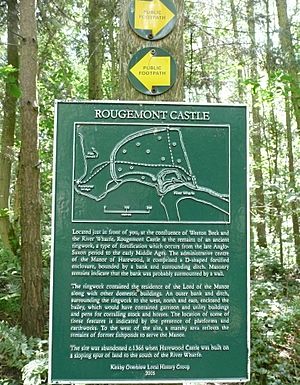Rougemont Castle, Weeton facts for kids
Rougemont Castle is a very old ruined castle in a place called Harewood, in Weeton, North Yorkshire, England. It's mostly hidden in thick woods. You can find it southeast of Weeton village, near the River Wharfe. Today, you won't see any stone buildings standing. But you can still spot the old earthworks. These are like big bumps and ditches in the ground. They show where the castle once stood, including its walls, ditches, and even fish ponds.
The Castle's Story
Who Lived There?
Rougemont Castle was once home to an important family called de Lisle. One member, Robert de Lisle, was given a special title in 1311. He became "Baron Lisle of Rougemont." This helped people tell him apart from other families with a similar name.
The castle was the main office for the Harewood area. It was also where the local lord, or ruler, lived. It was a busy and important place for many years.
Why Was It Left?
Around the year 1366, the de Lisle family decided to move. They built a new castle nearby called Harewood Castle. This new castle was made of stone. Because of this new home, Rougemont Castle was no longer needed. It was left empty and slowly fell into ruin.
Harewood Castle itself was also left empty later on, around the 1600s. In 1738, a family called Lascelles bought the land. They built a grand new house called Harewood House. This beautiful mansion is still there today. The Lascelles family was later given the title "Earl of Harewood" in 1812.


